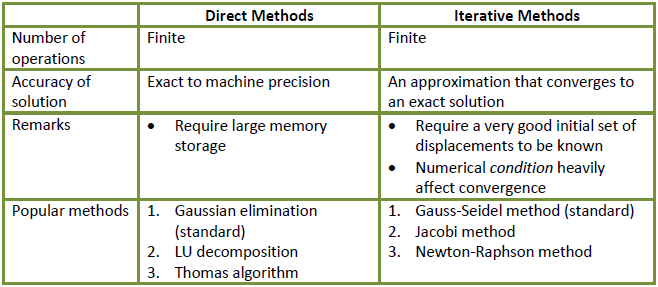- Derive local stiffness matrices (k)
- Assemble k into K, the global stiffness matrix
June 30, 2013
Steps to Derive k and Assemble into K
Figure 1 is a flowchart illustrating the sequence for computing the stiffness matrix of a simple problem (the concept is similar to more complex problems). Computing the stiffness matrix involves two main steps:
June 22, 2013
Matrix Methods: Direct vs. Iterative
Direct vs. Iterative methods
The two approaches available for solving global stiffness matrix (K) in FEM are:

The two approaches available for solving global stiffness matrix (K) in FEM are:

Implications on FEA solver
- For linear simulation e.g. KU = f , Gaussian elimination can be applied directly
- For nonlinear simulation e.g. K(u)U=f, stiffness is dependent on displacements (u). Therefore an iterative method must be used.
June 06, 2013
What is Meshing?
Meshing involves:
- discretisation of a continuum into finite number of elements
- defining element type (determined by shape functions)
- nodal connectivity
 |
| A finite element mesh adapted from Dr TE Kendon's research page |
Traditionally, meshing is performed by human user. Automatic meshing technologies are becoming more readily available and user friendly in FEA pre-processors as the competition in the FEA software market gets fierce than ever.
Also read
May 31, 2013
Virtual Work and Weak Formulation
Weak formulations (a.k.a. variational formulations) of partial differential equations (PDEs) are hugely important in the FEM as they enable the concepts of linear algebra in the analysis of PDEs. This concept transform PDEs into sets of linear equations (a matrix) that can eventually be manipulated and inverted using standard matrix methods.
Transforming an equation from strong to weak form requires the use of virtual function, and hence the name Principle of Virtual Work.
Also read
A few worked examples (external pdf)
The role of the Principle of Virtual Work in FEM
Transforming an equation from strong to weak form requires the use of virtual function, and hence the name Principle of Virtual Work.
Also read
A few worked examples (external pdf)
The role of the Principle of Virtual Work in FEM
May 25, 2013
Boundary Conditions (BCs) vs. Displacement BCs in FEM
This post aims to address the question that arises when one cannot distinguish between boundary conditions (BCs) and displacement BCs in the flowchart of FEM process.
Since FEM is all about solving the FE equation in matrix form, we approach this question using the classic FE equation of a linear elastic problem, KU = f. Let us assume it expands to look like Figure 1:
Since FEM is all about solving the FE equation in matrix form, we approach this question using the classic FE equation of a linear elastic problem, KU = f. Let us assume it expands to look like Figure 1:
 |
| Figure 1: FE Equation of a linear elastic problem, KU = f |
We can now interpret the difference between BCs and displacement BCs from the physical and mathematical perspectives:
May 10, 2013
Steps in FEM: An Overview
Figure 1 is a flowchart illustrating the FEM process for a linear static problem (the concept is similar to more complex problems):
Brief explaination of the different stages in Figure 1:
 |
| Figure 1: A finite element method process for solving linear static problems (Click to enlarge) |
Subscribe to:
Posts (Atom)